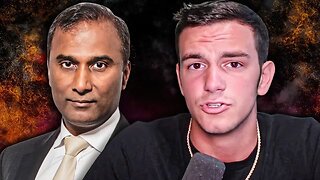INDIA'S HIDDEN SECRETS REVEALED? Evidence of Ancient Engineering Technology | Praveen Mohan
𝗪𝗲 𝗻𝗲𝗲𝗱 𝘆𝗼𝘂𝗿 𝘀𝘂𝗽𝗽𝗼𝗿𝘁:
If you feel this work is important to be done in the current times, please help us out in producing more such content.
► PayPal :- https://paypal.me/hindutvawadi
★ Instagram :- https://instagram.com/praveenET
★ Twitter :- https://twitter.com/IamPraveenMohan
★ Email id :- phenomenaltravelvideos@gmail.com
00:00 - Vishwakarman
01:02 - Theodolite
01:57 - Leveling Staff
03:25 - Multi Headed God?
04:47 - Plumb Bob
06:41 - Soil Probe
07:55 - Resonance devices?
09:56 - Vishwakarman & Lord Brahma
11:12 - Conclusion
Hey guys, today we are going to look at an ancient Hindu architect called Vishvakarman, and how everything we know about him is wrong. This 900 year old carving shows Vishwakarman with multiple heads and holding various weapons - this is the standard explanation we get. But that is pure nonsense. If he has multiple heads, then how come the center head looks older while the other 2 heads show younger faces. And look at the weapon on the left, it is not a weapon at all, this head is actually looking into this device. Now who is Vishwakarman? According to Ancient Indian texts, Vishwakarman was the architect who engineered great cities like Dwaraka and Ancient Temples with insane perfection. An architect does not need weapons, so what is this device he is looking through? He is using a theodolite.
Now what is a theodolite? Have you ever wondered why you always see civil engineers standing and looking through something? That is a theodolite, it is similar to a small telescope. And look at the similarity of the modern theodolite and how the engineer is looking through it and how the ancient theodolite is shown and how this face is clearly looking through it. It is a perfect match. But what is the purpose of a theodolite? It is used to make sure that an area is perfectly flat or horizontally leveled before construction starts. In real life, most areas have horizontal differences and how do you make it flat? On one end of the site, you have the theodolite and on the other end, you must place a leveling rod or a leveling staff, which has markings. This is exactly what we see in the other hand in this statue. This is the leveling rod, of course the marking are gone now because of erosion, but it is quite visible in other carvings of Vishwakarman. For example it is clearly visible in this statue - This is from the Sun Temple at Modhera, built around 1000 years ago. Other statues as well show clear markings, I had initially thought it was just a simple ruler or a line gauge, but now it is clear that Vishwakarman was using a leveling rod and a theodolite to survey construction sites. Here you see another carving where he is clearly holding a leveling rod in one hand and a theodolite in the other hand.
If you look at ancient temples, one of the things we marvel about is, how they were able to achieve such flatness of the ground before they started construction. Even on mountain tops, they were able to create perfectly flat plane and then build temples. Now, we can fully understand how they achieved this. The ancient builders carved the details quite clearly, this is not a multi-headed god. They are showing multiple people working the same site, one guy is looking through the theodolite, the other guy is in charge of the leveling rod, and the older guy with the beard is the supervisor. Another 1000 year old statue shows the same iconography with 2 younger guys on the side holding the same devices with the older guy in the middle, this is quite clear how they have carved Vishwakarman. Remember how civil engineers make 3d drawings, these three faces could be indicative of that as well.
This is very interesting because we have always thought that Vishwakarman was one person, but perhaps it denotes a team of ancient engineers, just like how a team of engineers works on a site today. And I have been researching Vishwakarman for many months now, and I have seen various combination of faces in ancient temples. Sometimes All young faces, sometimes all older faces and sometimes a combination of both young and old.
#AncientTechnology #Hinduism #PraveenMohan
-
 LIVE
LIVE
Right Side Broadcasting Network
6 days agoLIVE REPLAY: President Donald J. Trump Holds a Rally in Las Vegas, NV - 6/9/24
6,390 watching -
 16:09
16:09
Clownfish TV
9 hours agoMicrosoft DISABLES Windows Recall After MASSIVE Public Backlash!
16.8K36 -
 16:17
16:17
TENET Media
12 hours agoThe Shopping Cart Theory | Matt Christiansen
15.8K17 -
 17:55
17:55
JoBlo Originals
21 hours agoWhat Happened to EPIC MEAL TIME?
17.7K4 -
 31:02
31:02
Degenerate Plays
11 hours agoBest Girl Needs Her Swimsuit - Final Fantasy 7: Ever Crisis : Part 2
17K1 -
 48:14
48:14
World Nomac
1 day agoMy First Time in Shanghai, China 🇨🇳
19.1K4 -
 2:57:13
2:57:13
SNEAKO
11 hours ago"Who Do You Hate the Most?" - One Minute Podcast
92.2K89 -
 4:47:25
4:47:25
SonnyFaz
7 hours agoDr. Shiva x Sonny IRL
52.4K17 -
 4:28:03
4:28:03
LumpyPotatoX2
13 hours agoSub-Sunday on Rumble - #RumbleTakeover
64.7K4 -
 26:04
26:04
iamLucid
1 day agoVideo Game Piracy is Unstoppable
91.5K47